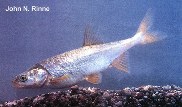http://www.fishbase.org/Summary/speciesSummary.php?genusname=Gila&speciesname=robusta ---> http://52.67.158.155/Summary/speciesSummary.php?genusname=Gila&speciesname=robusta
http://52.67.158.155/Summary/speciesSummary.php?genusname=Gila&speciesname=robusta ---> https://fishbase.net.br/Summary/speciesSummary.php?genusname=Gila&speciesname=robusta
https://fishbase.net.br/Summary/speciesSummary.php?genusname=Gila&speciesname=robusta ---> https://fishbase.net.br/summary/Gila-robusta.html
Gila robusta, Roundtail chub

You can
sponsor
this page
Common name (e.g. trout)
Genus + Species (e.g. Gadus morhua)
-

-
About this page
-
Languages
-
User feedbacks
-
Citation
-
Uploads
-
Related species
-


 Roundtail chub
Upload your
photos
and
videos
Roundtail chub
Upload your
photos
and
videos
Pictures
|
Google image
 Gila robusta
Gila robusta
Picture by
The Native Fish Conservancy
Teleostei (teleosts) >
Cypriniformes
(Carps) >
Leuciscidae
(Minnows) > Laviniinae
Etymology:
Gila:
A river flowing from SW Mejico to south Arizona
.
More on authors:
Baird
&
Girard
.
Environment: milieu / climate zone / depth range / distribution range
Ecology
Freshwater; benthopelagic. Subtropical; 44°N - 28°N
North America: Colorado River drainage in Wyoming, Colorado, Utah, New Mexico and Arizona, USA (Ref.
86798
); also Rio Yaqui south to Rio Piaxtla in northwestern Mexico (Ref.
5723
).
Size / Weight / Age
Maturity: L
m
?
range ? - ? cm
Max length : 43.0 cm TL male/unsexed; (Ref.
5723
); common length : 30.0 cm TL male/unsexed; (Ref.
12193
); max. reported age: 8 years (Ref.
12193
)
Dorsal
soft rays
(total): 9;
Anal
soft rays
: 9. Body deep and compressed. Head flat. Caudal peduncle slender. Caudal fin large and forked. Angle along base of the anal fin continues into the middle of the caudal fin. Mouth terminal, extending to front of eye. Dark olive-gray above, silver side. Breeding male may develop red or orange on lower half of cheek and paired-fin bases; Lateral line with 71-99 scales, usually more than 78. Dorsal and anal fins with 9 rays. First gill arch with 10 or more rakers. Pharyngeal teeth 2,5-4,2 (Ref.
86798
).
Inhabits rocky runs, sometimes pools, of creeks and small to large rivers as well as impoundments. May hybridize with
Gila cypha throughout their shared range except in Yampa River (Ref.
86798
).
Life cycle and mating behavior
Maturity
|
Reproduction
|
Spawning
|
Eggs
|
Fecundity
|
Larvae
Page, L.M. and B.M. Burr
, 2011. A field guide to freshwater fishes of North America north of Mexico. Boston : Houghton Mifflin Harcourt, 663p. (Ref.
86798
)
IUCN Red List Status (Ref.
130435
)
Vulnerable (VU)
(A2ce); Date assessed:
07 November 2018
CITES
Not Evaluated
Not Evaluated
Threat to humans
Harmless
Human uses
FAO - Publication:
search
|
FishSource
|
More information
Countries
FAO areas
Ecosystems
Occurrences
Introductions
Stocks
Ecology
Diet
Food items
Food consumption
Ration
Common names
Synonyms
Metabolism
Predators
Ecotoxicology
Reproduction
Maturity
Spawning
Spawning aggregation
Fecundity
Eggs
Egg development
Age/Size
Growth
Length-weight
Length-length
Length-frequencies
Morphometrics
Morphology
Larvae
Larval dynamics
Recruitment
Abundance
BRUVS
References
Aquaculture
Aquaculture profile
Strains
Genetics
Electrophoreses
Heritability
Diseases
Processing
Nutrients
Mass conversion
Collaborators
Pictures
Stamps, Coins Misc.
Sounds
Ciguatera
Speed
Swim. type
Gill area
Otoliths
Brains
Vision
Tools
E-book
|
Field guide
|
Length-frequency wizard
|
Life-history tool
|
Point map
|
Classification Tree
|
Catch-MSY
|
Special reports
Check for Aquarium maintenance
|
Check for Species Fact Sheets
|
Check for Aquaculture Fact Sheets
Download XML
Summary page
|
Point data
|
Common names
|
Photos
Internet sources
AFORO (otoliths) |
Aquatic Commons
|
BHL
|
Cloffa
|
BOLDSystems
|
Websites from users
|
Check FishWatcher
|
CISTI
|
Catalog of Fishes
:
genus
,
species
|
DiscoverLife
|
ECOTOX
| FAO - Publication:
search
|
Faunafri
| Fishipedia |
Fishtrace
| GenBank:
genome
,
nucleotide
|
GloBI
|
Google Books
|
Google Scholar
|
Google
| IGFA World Record |
MitoFish
|
Otolith Atlas of Taiwan Fishes
|
PubMed
| Reef Life Survey | Socotra Atlas |
Tree of Life
| Wikipedia:
Go
,
Search
| World Records Freshwater Fishing |
Zoobank
|
Zoological Record
Estimates based on models
Phylogenetic diversity index (Ref.
82804
): PD
50
= 0.5000 [Uniqueness, from 0.5 = low to 2.0 = high].
Bayesian length-weight: a=0.01148 (0.00455 - 0.02896), b=3.03 (2.81 - 3.25), in cm total length, based on LWR estimates for this (Sub)family-body shape (Ref.
93245
).
Trophic level (Ref.
69278
): 2.0 ±0.2 se; based on size and trophs of closest relatives
Resilience (Ref.
120179
): Medium, minimum population doubling time 1.4 - 4.4 years (tmax=8).
Fishing Vulnerability (Ref.
59153
): Low to moderate vulnerability (33 of 100).
Back to Search
Random Species
Back to Top
Accessed through:
Not available
FishBase mirror site :
Laguna, Philippines
Page last modified by :
mrius-barile
|